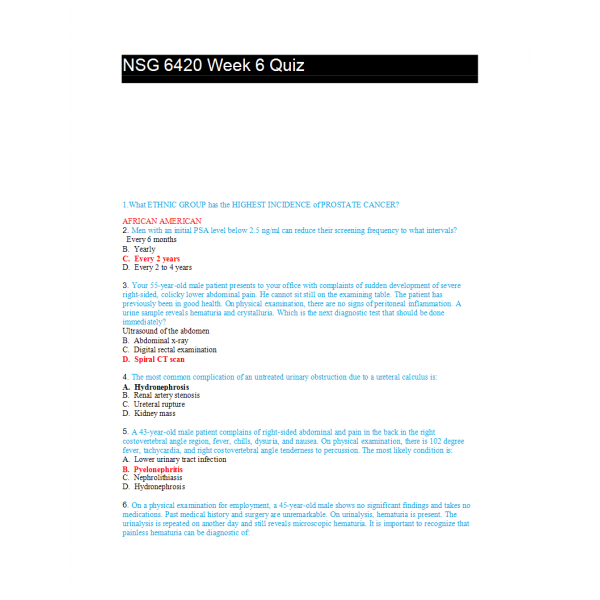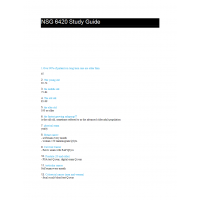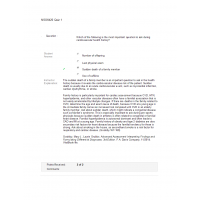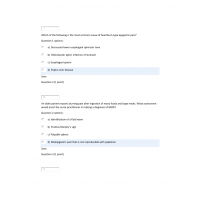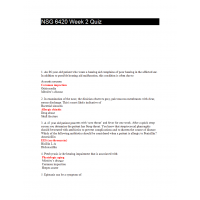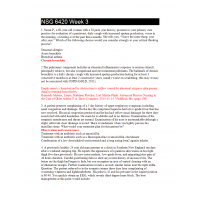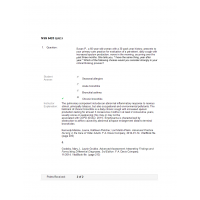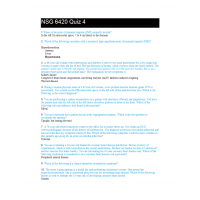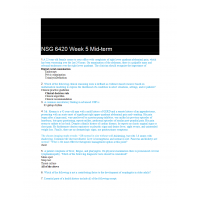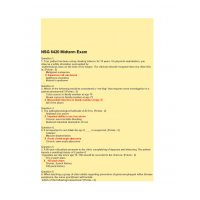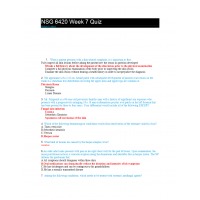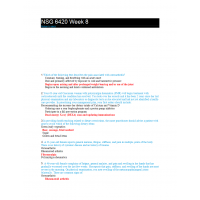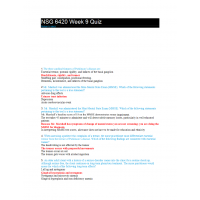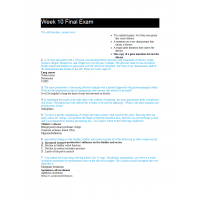NSG 6420 Week 6 Quiz
NSG 6420 Week 6 Quiz
1. What ETHNIC GROUP has the HIGHEST INCIDENCE of PROSTATE CANCER?
2. Men with an initial PSA level below 2.5 ng/ml can reduce their screening frequency to what intervals?
3. Your 55-year-old male patient presents to your office with complaints of sudden development of severe right-sided, colicky lower abdominal pain. He cannot sit still on the examining table. The patient has previously been in good health. On physical examination, there are no signs of peritoneal inflammation. A urine sample reveals hematuria and crystalluria. Which is the next diagnostic test that should be done immediately?
4. The most common complication of an untreated urinary obstruction due to a ureteral calculus is:
5. A 43-year-old male patient complains of right-sided abdominal and pain in the back in the right costovertebral angle region, fever, chills, dysuria, and nausea. On physical examination, there is 102 degree fever, tachycardia, and right costovertebral angle tenderness to percussion. The most likely condition is:
6. On a physical examination for employment, a 45-year-old male shows no significant findings and takes no medications. Past medical history and surgery are unremarkable. On urinalysis, hematuria is present. The urinalysis is repeated on another day and still reveals microscopic hematuria. It is important to recognize that painless hematuria can be diagnostic of:
7. On DRE, you note that a 45-year-old patient has a firm, smooth, non-tender but asymmetrically shaped prostate. The patient has no symptoms and has a normal urinalysis. The patient’s PSA is within normal limits for the patient’s age. The clinician should:
8. Age-related changes in the bladder, urethra, and ureters include all of the following in older women except:
9. Mr. Jones is a 68-year-old retired Air Force pilot that has been diagnosed with prostate cancer in the past week. He has never had a surgical procedure in his life and seeks clarification on the availability of treatments for prostate cancer. He asks the nurse practitioner to tell him the side effects of a radical prostatectomy. Which of the following is not a potential side effect of this procedure
10. our 77-year-old patient complains of frequent urination, hesitation in getting the stream started, and nocturnal frequency of urination that is bothersome. On DRE, there is an enlarged, firm, non-tender, smooth prostate. The clinician should recognize these as symptoms of:
11. Your 24-year-old female patient complains of dysuria as well as frequency and urgency of urination that develops the day after she uses her diaphragm. Urine culture reveals a bacterial count of 100 CFU/mL. These signs and symptoms indicate
12. A 79-year-old man is being evaluated for frequent urinary dribbling without burning. Physical examination reveals a smooth but slightly enlarged prostate gland. His PSA level is 3.3 ng/ml. The patient undergoes formal urodynamic studies, and findings are as follows: a decreased bladder capacity of 370 ml; a few involuntary detrusor contractions at a low bladder volume of 246 mL; an increased postvoid residual urine volume of 225 ml; and a slightly decreased urinary flow rate. Which of the following is not consistent with a normal age-associated change?
13. Mrs. L. Billings is a 77-year-old Caucasian female who has a history of breast cancer. She has been in remission for 6 years. As her primary care provider, you are seeing her for follow-up of her recent complaint of intermittent abdominal pain of a 3-month duration and some general malaise. Given the brief history above, what will you direct your assessment at during physical examination?
14. A 27-year-old male comes in to the clinic for symptoms of dysuria, urinary frequency, as well as urgency and perineal pain. Transrectal palpation of the prostate reveals a very tender, boggy, swollen prostate. The clinician should recognize these as signs of:
15. Which of the following males would be at greatest risk for testicular cancer?
16. A 43-year-old male patient complains of right-sided abdominal and pain in the back in the right costovertebral angle region, fever, chills, dysuria, and nausea. On physical examination, there is 102 degree fever, tachycardia, and right costovertebral angle tenderness to percussion. The most likely condition is:
17. Which of the following disorders can cause urinary incontinence?
18. Your 18 year old sexually active patient presents with sudden right sided groin pain that is sharp and constant. Inspection of his genitals reveals a swollen and erythematous right scrotum. His right testicle is exquisitely tender, swollen and has no palpable masses. Elevation of the testis results in no reduction in pain. The left scrotum and the testicle are normal. Epididymis and other scrotal contents were within normal limits. The scrotum does not transilluminate. Cremasteric reflex is present on the left side but absent on the right. There is no penile discharge, inguinal lymphadenopathy, or hernias.
19. The Prehn sign is utilized to distinguish epididymitis from testicular torsion. Epididymitis is considered when the Prehn sign is positive. When is the Prehn sign determined to be positive?
20. Which of the following exam findings makes the diagnosis of testicular tumor more likely?
| Institution & Term/Date | |
| Term/Date | South University |
-
$12.00

